EXUDATIVE EPIDERMITIS IN PIGS
Figure 1. Exudative Epidermitis:
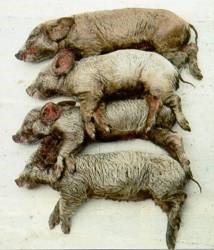 |
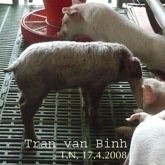 |
Lesions: Lesions are mainly on the pig’s skin. Due to the excessive exudate, the hair becomes matted, and many pigs may have difficulty suckling due to inflammation around the mouth, which can lead to death.
Diagnosis: Diagnosis is based on clinical symptoms and laboratory tests.
Differential Diagnosis: The disease needs to be differentiated from mange, zinc deficiency dermatitis, pityriasis rosea, and viral circovirus dermatitis.
- Mange: Mange is caused by Sarcoptes scabiei which burrows into the skin, and Demodex, also known as hair follicle mange, causing skin inflammation with itching. It spreads throughout the herd and is difficult to treat as mites persist in the farming environment.
- Zinc Deficiency Dermatitis: Pigs are prone to this condition when they weigh 20 – 60 kg, and pregnant sows are more susceptible during late pregnancy due to feeding dry feed, high corn or plant protein, or excessive calcium. Affected pigs exhibit hair loss and skin ulcers similar to mange, fungus, and exudative dermatitis, but unlike mange or fungus, it does not cause itching. Sows affected or weaned and bred multiple times may experience infertility. Exudative dermatitis usually affects suckling or weaned piglets. If infected, ulcers may become purulent and form plaques.
- Pityriasis Rosea: Characterized by large, linked lesions resembling ringworm. Lesions are round and usually start on the abdomen and extend to the hind legs. In severe cases, they may spread over the entire body. The disease resolves on its own after 6 – 8 weeks.
- Porcine Circovirus Dermatitis: This viral disease severely impacts productivity and is costly. Also known as “Wasting Syndrome” or “Dermatitis and Nephritis Syndrome,” it is characterized by skin inflammation, stunted growth, and nephritis in pigs aged 6 – 16 weeks.
Figure 2. Some Diseases Causing Dermatitis in Pigs:
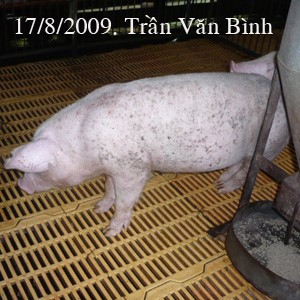
a. Pig Mange |
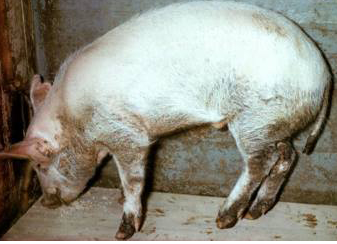
b. Zinc Deficiency Dermatitis |
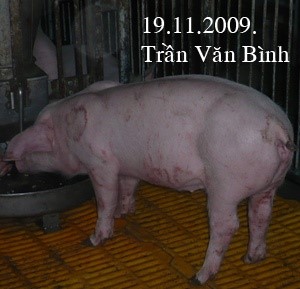
c. Pityriasis Rosea |
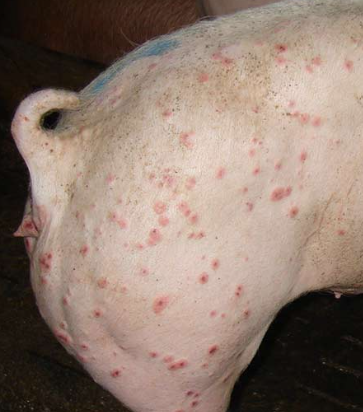
d. Circovirus-Associated Dermatitis |
Treatment: This disease can be treated, but it requires persistence, especially if sows carrying the disease are present. Combine hygiene and disinfection of the piggery with antibiotic treatment. Treat both piglets and sows.
For piglets:
- AMOX LA 15% (1 ml/10 kg body weight), LINCOSEPTIN, PNEUMOTIC (1 ml/5 kg body weight), or VINAENRO 5% (1 ml/10 – 20 kg body weight), intramuscular injection once daily for 3 – 5 days.
- VINA-DEXAFORT, intramuscular injection of 1 – 3 ml per piglet to reduce inflammation.
For sows:
- AMOX 50 or AMOXCOL, administered at 1 g/50 kg body weight per dose, twice daily for 7 days, with 2 – 3 courses (each course lasting 7 days) separated by 7 days.
Notes:
- If pigs are co-infected with mange, administer subcutaneously VINAMECTIN (1 ml/12 kg body weight) or IVERMECTIN (1 ml/33 kg body weight), with 2 injections 7 – 10 days apart.
- Methylen blue can be applied to the inflamed skin for disinfection.
- Disinfect the piggery (FORMACIN, VINADIN, B.K.VET) to eliminate the pathogen in the environment.
Prevention:
- Maintain cleanliness in the piggery. Ensure that the environment is dry, with humidity not exceeding 70% and temperature not excessively hot, which facilitates bacterial growth.
- Regularly disinfect the piggery (Formacin).
- In pig farms at risk of exudative dermatitis, treat all sows with AMOX 50 or AMOXCOL for 7 days per course, with 2 – 3 courses separated by 7 days to eliminate staphylococcal pathogens and other diseases such as MMA and white diarrhea in piglets.
